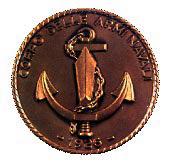If in the Sailing Navy the need was not felt for specific personnel responsible for naval weapons, starting from the 1886, with the establishment of the "Specialist" vessel officers, the task of running and maintaining artillery and underwater weapons was entrusted to officers of the General Staff trained with an adequate theoretical course and a period of experience in the Arsenal.
This solution was no longer satisfactory when the tasks on the ground became so numerous and complex that the "Specialist" officers could not be diverted to fulfill the required boarding and command duties. Thus it was that in the 1898 a small role of "Sedentary" officers was established within the General Staff Corps, which allowed career progression without complying with the prescribed boarding obligations. In this role the best "technical brains" of the General Staff flowed together, as did those officers deemed unfit for on-board employment. This circumstance meant that the "Sedentari" officers were considered second class with respect to the role of sailors, with consequent difficulties in ensuring an influx of gifted and motivated people to the ground services that a parliamentary commission of inquiry in the 1905 had called needy of "intelligent staff able to direct and command, and many indeed demanded technical knowledge and first-order experience".
The renaming of the "Sedentari" role in the role of "Executive Specialists", which took place in the 1908, did not substantially change the state of affairs and had to wait until the 1917, critical year of the first world war, to tackle the problem of a staff deficit in quantity and quality. In February of the 1918, the Military Corps of the "Naval Weapons Specialists" was set up by the Lieutenancy Decree, replacing the Naval Specialists Executive Directional. Between the two schools of thought that opposed a solution based on specialists from the General Staff to one formed by a new Corps of real engineers drawn from the civil world, the first prevailed. Therefore the Directional Specialists were replaced by the Specialists of the Naval Weapons (SAN) coming from a recruitment to demand among the pupils of vessel of the 4 ° year of the Naval Academy. The uniform was that of the other naval officers with a special Corps badge; the denomination of the degrees was that of the Army, and the seniority of the Corps was immediately following the officers of the Joint Staff. The career included a two-year specialization course and very short boarding periods for promotions up to the rank of lieutenant colonel. The economic treatment and age limits were the same as those of the Naval Engineering Corps.
After a short period of life of the new Corps, which gave no way to bring the formation process up to speed, in the middle of the 1919 the Lieutenancy Decree was not converted into law, and the Corps of Specialists of Naval Weapons was reconverted into the role of Naval Weapon Specialists.
The immediate first post-war period saw the need to have a qualified and motivated Body able to carry out the ever more complex tasks of study, design, experimentation, development, construction, installation on board and maintenance of the weapon systems. . The situation was aggravated by the moodiness of the Naval Arms Specialists who did not see their professionalism adequately recognized. All this was part of a period of great ferment for the beginning of a rearmament that required specialized skills not found in the existing organic of the Regia Marina.
These were the reasons that led to the 8 law July 1926, n.1178 on the order of the Royal Navy which established the Corps "for the" (then "of the") Naval Weapons, which was responsible for "studying the arming of ships of new construction and to arrange for the purchase and arrangement of the relative facilities; to study and provide for new weapons, armament materials, those for the optical service, those for the electric and radio-technical service, with the exception of the electric propulsion equipment of ships " .
Recruitment could take place through the Naval Academy for graduates, with competitions for direct nominations to an official for graduates, and a request for STV graduates. The denominations of the degrees were those of the Army. The new Corps were given the same badges as those provided in the 1918 for Naval Weapon Specialists, a anchor loaded with lightning bolts (E), torpedoes (T) and cannons (A), and the same gallons without a loop around the white cloth ( color that will change to black and finally, in the 1939, to the current brown). In the 1939 the bollard circle was extended to all the Corps of the Royal Navy. Finally, in the 1973 the denominations of the degrees were standardized, except for the last two apical degrees, modified in Admiral Inspector and Admiral Chief Inspector. The formation of AN Officers through the Naval Academy has always been the main source of recruitment (with only the 1935 being suspended from the 1940) and from the 1943 direct competitions between graduates were rare and very limited.
As for the Degree, in the immediate post-war period the one in Industrial Engineering was foreseen, with addresses in Electrotechnics, Mechanics, Aeronautics and Chemistry. With the progress of technology, the prevailing and finally unique direction was that in Electronic Engineering.
Source: Military Navy












